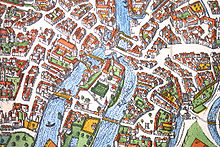Geyerswörth residential palace

The Geyerswörth residential palace is a former city palace in Bamberg's old town . It is named after the Geyer family from Nuremberg . In 1313, the Geyer patrician family built a city palace here, giving the place its current name. In 1585/1586 the family moved to Nuremberg and left the building to the Bamberg prince-bishop Ernst von Mengersdorf.
history
After 1585/1586, Prince-Bishop Ernst von Mengersdorf had the Geyer family's property rebuilt and built today's palace in the Renaissance style
In 1580 - after previous partial purchases since the reign of Prince-Bishop Veit II von Würtzburg - the site and the castle of the Geyer family fell to the Bamberg Monastery .
Prince-Bishop Johann Georg I. Zobel von Giebelstadt (ruled from 1557 to 1580) had a park created south of the palace that no longer exists today. Today only the gardener's house in solid and half-timbered construction, which is used as a student residence in the Mühlviertel, bears witness to this park.
After reconstruction in the Renaissance style, including the old building, the building served as the town seat of the prince-bishops; Prince-Bishop Ernst von Mengersdorf is the client (coat of arms on the outside of the southwest side). It was probably the headquarters of the ruling bishops until the end of the construction work on the New Residence. The coat of arms of the Bamberg Prince-Bishop Marquard Sebastian Schenk von Stauffenberg can be seen on the fountain in the inner courtyard.
After the construction work on Domberg was completed, the castle was largely used as an administration building. After the collapse of the two Renaissance gables on the north side in the 1740s, it got its present appearance.
The castle is used by the authorities of the city of Bamberg.
Web links
Individual evidence
- ↑ a b Werner Dettelbacher, Stefan Fröhlich, Andreas Reuss: Franconia . Ed .: Dumont Art Travel Guide. Cologne 2001, ISBN 3-7701-4186-5 , p. 160 .
Coordinates: 49 ° 53 ′ 28.2 " N , 10 ° 53 ′ 16.2" E


